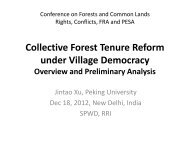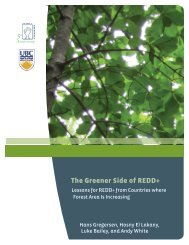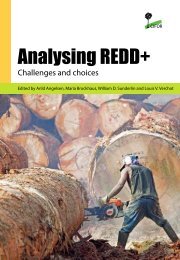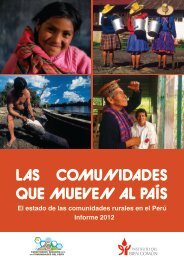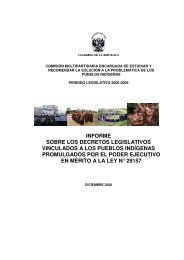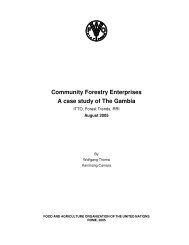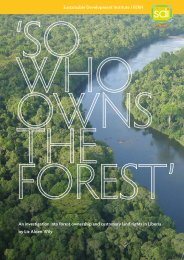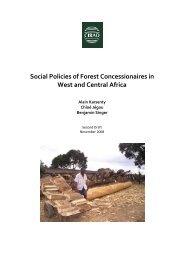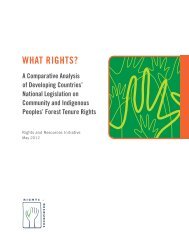Kristen Hite February 7, 2011 - Rights and Resources Initiative
Kristen Hite February 7, 2011 - Rights and Resources Initiative
Kristen Hite February 7, 2011 - Rights and Resources Initiative
Create successful ePaper yourself
Turn your PDF publications into a flip-book with our unique Google optimized e-Paper software.
<strong>Kristen</strong> <strong>Hite</strong><strong>February</strong> 7, <strong>2011</strong>
• (a) )Actions complement or are consistent t with the objectives of national forestprogrammes Utilize national <strong>and</strong> relevant laws international <strong>and</strong> conventions systems <strong>and</strong> that agreements; supportREDD, have good governance structures, <strong>and</strong> areconsistent t with international ti obligations.• (b) Transparent <strong>and</strong> effective national forest governance structures, taking intoaccount national legislation <strong>and</strong> sovereignty;• (c) Respect for the knowledge <strong>and</strong> rights of indigenous peoples <strong>and</strong> members oflocal communities, by taking into account relevant international obligations,nationalRespectcircumstancesthe rights<strong>and</strong> laws,of<strong>and</strong>indigenousnoting that thepeoplesUnited Nations<strong>and</strong>GenerallocalAssembly has adopted the United Nations Declaration on the <strong>Rights</strong> of Indigenous Peoples;communities <strong>and</strong> involve them in decision-making.i • (d) The full <strong>and</strong> effective participation of relevant stakeholders, in particular,indigenous Comply peoples with <strong>and</strong> international local communities, obligations.in actions referred to in paragraphs 70<strong>and</strong> 72 of this decision;• (e) Actions are consistent with the conservation of natural forests <strong>and</strong> biologicaldiversity, ensuring that actions referred to in paragraph 70 of this decision are notDon’t destroy biodiversity or ecosystems.used for the conversion of natural forests, but are instead used to incentivize theprotection <strong>and</strong> conservation of natural forests <strong>and</strong> their ecosystem services, <strong>and</strong> toenhance other social <strong>and</strong> environmental benefits;Make sure trees are not cut down elsewhere.• (f) Actions to address the risks of reversals;• (g) Actions to reduce displacement of emissions.Source: COP 16 LCA Decision, ANNEX I, Paragraph 2
• Institutionalpolicy/procedure to protectagainst social <strong>and</strong>environmental harm• Identifies, evaluates,minimizes, <strong>and</strong> mitigatesadverse impacts• Focus on sustainabledevelopment—part ofdevelopment dialogue
• Safeguards help minimize risk <strong>and</strong> improveoutcomes.• International recognition of the need to respectst<strong>and</strong>ards.• Dem<strong>and</strong> for compliance is universal.• St<strong>and</strong>ards <strong>and</strong> rights help resolve conflicts.
• ANTICIPATE –- AVOID –– MITIGATE• Impacts need to include environmental, social,<strong>and</strong> human rights analyses.• Much of remaining forests is found inindigenous l<strong>and</strong>s: respecting traditionalmanagement gets a better outcome.• Protecting biodiversity <strong>and</strong> ecosystems meansless deforestation ti <strong>and</strong> better outcomes.• REDD requires special consideration of l<strong>and</strong><strong>and</strong> resource tenure <strong>and</strong> customary rights
• UN-REDD: UN system requirements <strong>and</strong> UN-REDD guidance• FIP: World Bank Policies i <strong>and</strong> Procedures +other MDB policies <strong>and</strong> procedures• FCPF: World Bank Policies <strong>and</strong> Procedures +international obligations• Bilateral funds: international instruments, donor<strong>and</strong> recipient national laws <strong>and</strong> policies• National funds: international <strong>and</strong> national laws<strong>and</strong> policiesi
• UN-REDD adopts a rights-based approach to itsactivities.• Applies UNDRIP• Applies FPIC• Applies UNDG Guidelines on Indigenous Peoples• International obligations apply at different levels:• International: human rights <strong>and</strong> other obligations• National: human rights, UN-REDD guidance• Sub-national: States <strong>and</strong> private actors still haveinternational obligations• Lacks proscriptive policies i <strong>and</strong> procedures.
• Convention on Biological i l Diversityi• United Nations Declaration on the <strong>Rights</strong> of IndigenousPeoples• Universal Declaration on Human <strong>Rights</strong>• International Covenant on Economic, Social <strong>and</strong>Cultural <strong>Rights</strong>• International Covenant on Civil <strong>and</strong> Political <strong>Rights</strong>• International Convention on the Elimination of AllForms of Racial Discrimination• ILO Convention 169• Convention on the Protection <strong>and</strong> Promotion of theDiversity of Cultural Expressions
• Each MDB uses funds in accordance withits own policies, guidelines, <strong>and</strong>procedures.• Common “overlay” environmental <strong>and</strong>social criteria apply to all MDBs.• WB is trustee <strong>and</strong> follows its ownOperational Policies i <strong>and</strong> Procedures.• Missing: a rights-based approach, norequirement for FPIC or UNDRIP.
• Requires compliance with the World Bank’sOperational Policies <strong>and</strong> Procedures• Recognizes need for effective participation ofForest-Dependent Indigenous Peoples <strong>and</strong>Forest Dwellers• Respects rights of indigenous peoples <strong>and</strong>forest-dependent communities under nationallaws <strong>and</strong> international obligations.• World Bank Staff have consistently affirmed that allsafeguards apply to FCPF activities, including atlast year’s dialogue.• Missing: no FPIC requirement, WB policiesinconsistent with UNDRIP.
• 4.01 Environmental Assessment• 4.04 404Natural lHabitats• 4.12 Involuntary Resettlement• 4.15 Poverty Reduction• 4.20 Indigenous People• 4.36 Forests• 7.60 Projects in Disputed Areas• 11.03 Cultural Property• 13.05 Project SupervisionFind the policies here: http://go.worldbank.org/3GLI3EECP0NOTE: Application of these procedures to specific WB activities may dependupon the type of support involved. For example, if this is investment lending,they do apply, as per OP 4.10.NOTE 2: World Bank operational policies <strong>and</strong> procedures do not address l<strong>and</strong>tenure in a comprehensive manner.
• No st<strong>and</strong>ardized “safeguard” framework• Institutional policies can be difficult toharmonize• UN: rights-based approach• MDBs: varying policies <strong>and</strong> procedures• Incorporating UNFCCC, UNDRIP, <strong>and</strong> CBD• Consistency at national level while increasingcountry ownership.• Means of recourse/accountability vary• UNFCCC: guidance to be developed
• Sequencing: agree on rules FIRST (includingsafeguards) to ensure effective outcome.• UNFCCC SBSTA safeguards guidance:national level systems• World Bank is revising its safeguards• CBD safeguards under development• L<strong>and</strong> <strong>and</strong> resource tenure: who has the right toa tree? To the carbon?• Managing conflict: accountability <strong>and</strong> Redress
• <strong>Rights</strong>-based approach withproscriptive policies <strong>and</strong> procedures• Fully considers both social <strong>and</strong>environmental impacts• Coherent with internationalobligations, including UNDRIP• Protect biodiversity <strong>and</strong> ecosystems• Participatory decision-makingprocesses, including FPIC• Robust information disclosure +transparency• Accessible recourse mechanism
Questions? Email khite@ciel.org



